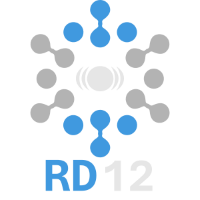Speaker
Description
Beam damage to biological specimens is more troublesome in the TEM than in x-ray imaging (where the spatial resolution is more modest) despite the stronger diffraction signal provided by electrons [1]. One solution has been to treat tissue (and other) specimens with heavy-metal stain but the preference is to use unstained samples and phase contrast, while cooling the sample to reduce damage (cryo-EM).
Whereas the electron optics of a TEM can provide atomic-scale contrast, the image resolution for a beam-sensitive sample is usually limited by the effects of radiolysis. The signal/noise ratio (SNR) in the image is then determined by beam-electron shot noise and the damage-limited resolution is given [2] by
(1) $\mathrm{DLR }=(\mathrm{SNR})C^{-1}[(\mathrm{DQE})F D_{c}]^{{-\frac{1}{2}}}$
Optimizing resolution involves paying attention to each term in Eq. (1). SNR is usually taken as 3 or 5 (the Rose criterion) but a large improvement is possible if there are multiple copies of the same object, as in diffraction imaging or single-particle analysis (SPA). The image contrast C is high in dark-field mode but for thin samples the electron-collection efficiency F is low. Phase contrast is efficient but is problematic for thicker samples, as required for most tomographic (3-dimensional) imaging. The detective quantum efficiency (DQE) of the electron detector can be maximized by using direct recording, rather than employing a scintillator.
The characteristic dose Dc represents the maximum fluence that the specimen can withstand before the structure being observed is degraded. Dc can be increased by cooling the sample with liquid nitrogen or liquid helium [3] or by coating it with an evaporated layer, and graphene encapsulation seems to be even more effective
Dose rate seems to have little effect on the radiolysis damage to organic specimens, except for secondary effects (mass loss) at a low specimen temperature and at the high dose rates (>1015 Gy/s) possible in scanning-mode TEM (STEM). Unlike XFEL x-ray imaging, it will likely remain impossible to outrun the primary stage of damage with electrons, due to their electrostatic repusion. Earlier reports of two-fold damage reduction using femtosecond electron pulses have recently been disputed [4].
References
[1] Henderson, R. (1995) Q. Rev. Biophys., 28, 171-193.
[2] Egerton, R.F. (2024) Micron, 177, 103576.
[3] Naydenova, K. et al. (2022) Ultramicroscopy, 237, 113512.
[4] Zhao, Y. et al. (2024) bioRxiv preprint: https://10.1101/2024.12.20.629524

